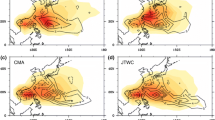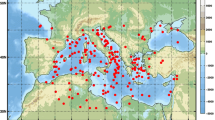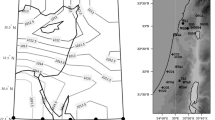Abstract
Trajectories of surface cyclones and anticyclones were constructed using an automated scheme by tracking local minima and maxima of mean daily sea level pressure data in the NCEP-NCAR reanalysis and the Centre National de Recherches Météorologiques coupled global climate Model (CNRM-CM3) SRES A2 integration. Mid-latitude lows and highs traveling in the North Pacific were tracked and daily frequencies were gridded. Transient activity in the CNRM-CM3 historical simulation (1950–1999) was validated against reanalysis. The GCM correctly reproduces winter trajectories as well as mean geographical distributions of cyclones and anticyclones over the North Pacific in spite of a general under-estimation of cyclones’ frequency. On inter-annual time scales, frequencies of cyclones and anticyclones vary in accordance with the Aleutian Low (AL) strength. When the AL is stronger (weaker), cyclones are more (less) numerous over the central and eastern North Pacific, while anticyclones are significantly less (more) numerous over this region. The action of transient cyclones and anticyclones over the central and eastern North Pacific determines seasonal climate over the West Coast of North America, and specifically, winter weather over California. Relationships between winter cyclone/anticyclone behavior and daily precipitation/cold temperature extremes over Western North America (the West) were examined and yielded two simple indices summarizing North Pacific transient activity relevant to regional climates. These indices are strongly related to the observed inter-annual variability of daily precipitation and cold temperature extremes over the West as well as to large scale seasonally averaged near surface climate conditions (e.g., air temperature at 2 m and wind at 10 m). In fact, they represent the synoptic links that accomplish the teleconnections. Comparison of patterns derived from NCEP-NCAR and CNRM-CM3 revealed that the model reproduces links between cyclone/anticyclone frequencies over the Northeastern Pacific and extra-tropical climate conditions but is deficient in relation to tropical climate variability. The connections between these synoptic indices and Western weather are well reproduced by the model. Under advanced global warming conditions, that is, the last half of the century, the model predicts a significant reduction of cyclonic transients throughout the mid-latitude North Pacific with the exception of the far northern and northeastern domains. Anticyclonic transients respond somewhat more regionally but consistently to strong greenhouse forcing, with notably fewer anticyclones over the Okhotsk/Kamchatka sector and generally more anticyclones in the Northeastern Pacific. These modifications of synoptic weather result in regional feedbacks, that is, regional synoptic alterations of the anthropogenic warming signal around the North Pacific. In the eastern Pacific, for example, synoptic feedbacks, having to do especially with the northward shift of the eastern Pacific storm-track (responding, in turn, to a weaker equator-to-pole temperature gradient), are favorable to more anticyclonic conditions off the American mid-latitude west coast and more cyclonic conditions at higher latitudes. These circulation feedbacks further reduce the equator-to-pole temperature gradient by favoring high-latitude mean winter warming especially over a broad wedge of the Arctic north of the Bering Sea and moderating the warming along the mid-latitude west coast of north America while also reducing precipitation frequencies from California to Northern Mexico.















Similar content being viewed by others
References
Anderson JR, Gyakum JR (1989) A diagnostic study of Pacific Basin circulation regimes as determined from extratropical cyclone tracks. Mon Weather Rev 117:2672–2686
Barnston AG, Livezey RE (1987) Classification, seasonality, and persistence of low-frequency atmospheric circulation patterns. Mon Weather Rev 115:1083–1126
Chapelon N, Douville H, Kosuth P, Oki T (2002) Off-line simulation of the Amazon water balance: a sensitivity study with implications for GSWP. Clim Dyn 19:141–154
Déqué M, Braum A, Piedelievre JP, Marquet P, Daudin P, Guérémy JF, Geleyn JF, Bazile E, Piriou JM, Yessad K, Courtier P, Rochas P (1999) ARPEGE version 3, documentation algorithmique et mode d’emploi (in French, available from CNRM/GMGEC, Météo-France, 42 avenue G. Coriolis, 31057 Toulouse, France)
Dettinger M, Remond K, Cayan DR (2004) Winter orographic precipitation ratios in the Sierra Nevada-Large-scale atmospheric circulations and hydrologic consequences. J Hydrometeor 5:1102–1116
Douville H, Royer JF, Mahfouf JF (1995a) A new snow parametrization for the Météo-France climate model Part I: Validation in stand-alone experiments. Clim Dyn 12:21–35
Douville H, Royer JF, Mahfouf JF (1995b) A new snow parametrization for the Météo-France climate model. Part II: Validation in a 3-D GCM experiments. Clim Dyn 12:37–52
Easterling DR (2002) Recent changes in frost days and the frost-free season in the United States. Bull Am Meteor Soc 83:1327–1332
Favre A, Gershunov A (2006) Extra-tropical cyclonic/anticyclonic activity in North-Eastern Pacific and air temperature extremes in Western North America. Clim Dyn 26:617–629
Geng Q, Sugi M (2003) Possible change of extratropical cyclone activity due to enhanced greenhouse gases and sulfate aerosols-Study with a high resolution AGCM. J Clim 16:2262–2274
Gershunov A, Cayan D (2003) Heavy daily precipitation frequency over the contiguous United States: Sources of climatic variability and seasonal predictability. J Clim 16:2752–2765
Gibelin AL, Déqué M (2003) Anthropogenic climate change over the Mediterranean region simulated by a global variable resolution model. Clim Dyn 18:225–240
Graham NE, Diaz HF (2001) Evidence for intensification of North Pacific winter cyclones since 1948. Bull Am Meteor Soc 82:1869–1992
Groisman PY, Knight RW, Karl TR, Easterling DR, Sun B, Lawrimore JM (2004) Contemporary changes of the hydrological cycle over the contiguous United States: trends derived from in-situ observations. J. Hydrometeor 5:64–85
Gulev SK, Zolina O, Grigoriev S (2001) Extratropical cyclone variability in the Northern Hemisphere winter from the NCEP/NCAR reanalysis data. Clim Dyn 17:795–809
Gyakum JR, Anderson JR, Grumm RH, Gruner EL (1989) North Pacific cold-season surface cyclone activity. Mon Weather Rev 117:1141–1155
Hanson HP, Long B (1985) Climatology of cyclogenesis over the East China Sea. Mon Weather Rev 113:697–707
Holland MM, Bitz CM (2003) Polar amplification of climate change in coupled models. Clim Dyn 21:221–232
IPCC (2007) Working Group I, Climate Change 2007: The Physical Science basis
Jhun JG, Lee EJ (2004) A new East Asian winter monsoon index and associated characteristics of the winter monsoon. J Clim 17:711–726
Kalnay E, Kanamitsu M, Kistler R, Collins W, Deaven D, Gandin L, Iredell M, Saha S, White G, Woollen J, Zhu Y, Leetmaa A, Reynolds B, Chelliah M, Ebisuzaki W, Higgins W, Janowiak J, Mo KC, Ropelewski C, Wang J, Jenne R, Joseph D (1996) The NCEP/NCAR 40-year reanalysis project. Bull Am Meteor Soc 77:437–471
Karl TR, Kukla G, Gavin J (1984) Decreasing diurnal temperature range in the United States and Canada from 1941 through 1980. J Applied Meteor 23:1489–1504
Karl TR, Kukla G, Gavin J (1986) Relationship between decreased temperature range and precipitation trends in the United States and Canada, 1941–80. J Applied Meteor 25:1878–1886
Karl TR, Jones PD, Knight RW, Kukla G, Plummer N, Razuvayev V, Gallo KP, Lindseay J, Charlson RJ, Petersen TC (1993) A new perspective on recent global warming: asymmetric trends of daily maximum and minimum temperature. Bull Am Meteo Soc 74:1007–1023
Koenig WR, Sausen R, Sielmann F (1993) Objective identification of cyclones in GCM simulations. J Clim 6:2217–2231
Kistler R, Kalnay E, Collins W, Saha S, White G, Woollen J, Chelliah M, Ebisuzaki W, Kanamitsu M, Kousky V, van den Dool H, Jenne R, Fiorino M (2001) The NCEP-NCAR 50-year reanalysis: monthly means CD-ROM and documentation. Bull Amer Meteor Soc 82:247–267
Klein WH (1957) Principal tracks and mean frequencies of cyclones and anticyclones in the Northern Hemisphere. Weather bureau research paper no.40, US Department of Commerce, NOAA, Washington, D.C., pp 60
Lambert SJ (1995) The effect of enhanced greenhouse warming on winter cyclone frequencies and strengths. J Clim 8:1447–14452
Lambert SJ (1996) Intense extratropical Northern Hemisphere winter cyclone events: 1899–1991. J Geophys Res 101:319–325
Lambert SJ, Fyfe JC (2006) Changes in winter cyclone frequencies and strengths simulated in enhanced greenhouse warming experiments: results from the models participating in the IPCC diagnostic exercise. Clim Dyn 26:713–728
Lambert SJ, Sheng J, Boyle J (2002) Winter cyclone frequencies in thirteen models participating in the Atmospheric Model Intercomparison Project (AMIP1). Clim Dyn 19:1–16
Lunkeit F, Bauer SE, Fraedrich K (1998) Storm tracks in a warmer climate: sensitivity studies with a simplified global circulation model. Clim Dyn 14:813–826
Madec G, Delecluse P, Imbard M, Lévy C (1998) OPA version 8.1 Ocean general circulation model reference manual, Notes du Pôle de Modélisation, Institut Pierre-Simon Laplace, no. 11, pp 91 [Available from Laboratoire d’Océanographie Dynamique et de Climatologie, Université Paris VI, Paris 75252, France]
Mahfouf JF, Manzi A, Noilhan J, Giordani H, Déqué M (1995) The land surface scheme ISBA within the Météo-France climate model ARPEGE Part I: Implementation and preliminary results. J Clim 8:2039–2057
McCabe GJ, Clark MP, Serreze MC (2001) Trends in Northern Hemisphere surface cyclone frequency and intensity. J Clim 14:2763–2768
McLay JG, Martin JE (2002) Surface cyclolysis in the North Pacific Ocean Part III: Composite local energetics of tropospheric-deep cyclone decay associated with rapid surface cyclolysis. Mon Wea Rev 130:2507–2529
Mantua NJ, Hare SR, Zhang Y, Wallace JM, Francis RC (1997) A Pacific interdecadal climate oscillation with impacts on salmon production. Bull Amer Meteor Soc 78:1069–1079
Martin JE, Grauman RD, Marsili N (2001) Surface cyclolysis in the North Pacific Ocean Part I: a synoptic climatology. Mon Wea Rev 129:748–765
Miranda S (2003) Actualizacion de la base de datos ERIC II. Final report of the project TH–0226, IMTA internal reports
NCDC (2003) Data documentation for data set 3200 (DSI–3200) Surface land daily cooperative summary of the day. National Climatic Data Center, Asheville, NC, p 36 [www.ncdc.noaa.gov/pub/data/documentlibrary/tddoc/td3200.pdf.]
Noilhan J, Planton S (1989) A simple parameterization of land surface processes for meteorological models. Mon Wea Rev 117:536–549
Oki T, Sud YC (1998) Design of Total Runoff Intergrating Pathways (TRIP) A global river channel network. Earth Interactions, vol 2. paper 1
Overland JE, Adams JM, Bond NA (1999) Decadal variability of the Aleutian Low and its relation to high-latitude circulation. J Clim 12:1542–1548
Panagiotopoulos F, Shahgedanova M, Hannachi A, Stephenson DB (2005) Observed trends and teleconnections of Siberian High: a recently declining center of action. J Clim 18:1411–1422
Pettersen S (1956) Weather analysis and forecasting, vol 1. McGraw-Hill, pp 422
Pezza AB, Ambrizzi T (2003) variability of Southern Hemisphere cyclone and anticyclone behavior: further analysis. J Clim 16:1075–1083
Ralph FM, Neiman PJ, Rotunno R (2004) Dropsonde observations in low-level jets over the Northeastern Pacific Ocean from CALJET-1998 and PACJET-2001: mean vertical-profile and atmospheric-river characteristics. Mon Wea Rev 133:889–910
Reed RJ, Albright (1986) A case study of explosive cyclogenesis in the eastern Pacific. Mon Wea Rev 114: 2297–2319
Roebber PJ (1984) Statistical analysis and updated climatology of explosive cyclones. Mon Wea Rev 112:1577–1589
Roebber PJ (1989) On the statistical analysis of cyclone deepening rates. Mon Wea Rev 117:2293–2298
Rogers E, Bosart LF (1986) An investigation of explosively deepening oceanic cyclones. Mon Wea Rev 114:702–718
Salas Mélia D (2002) A global coupled sea ice-ocean model. Ocean Model 4:137–172
Salas-Mélia D, Chauvin F, Déqué M, Douville H, Guérémy JF, Marquet P, Planton S, Royer JF, Tyteca S (2005) Description and validation of the CNRM-CM3 global coupled model, CNRM working note 103
Sanders F, Gyakum JR (1980) Synoptic-dynamic climatology of the “bomb”. Mon Wea Rev 108:1589–1606
Serreze MC, Carse F, Barry RG, Rogers JC (1997) Icelandic low cyclone activity: climatological features, linkages with the NAO, and relationships with the recent changes in the northern hemisphere circulation. J Clim 10:453–464
Sewall JO (2005) Precipitation shifts over western North America as a result of declining Arctic sea ice cover: The coupled system response. Earth Interactions 9:1–23
Sewall, JO, Sloan LC (2004) Disappearing Arctic sea ice reduces available water in the American west. Geophys Res Lett 31:L06209. doi:10.1029/2003GL019133
Simmonds I, Keay K (2000a) Mean Southern Hemisphere extra-tropical cyclone behavior in the 40-year NCEP-NCAR reanalysis. J Clim 13:873–885
Simmonds I, Keay K (2000b) Variability of Southern Hemisphere extra-tropical cyclone behaviour, 1958–1997. J Clim 13:550–561
Trenberth KE (1990) Recent observed interdecadal climate changes in the Northern Hemisphere. Bull Amer Meteor Soc 71:988–993
Trenberth KE, Hurrell JW (1994) Decadal atmosphere-ocean variations in the Pacific. Clim Dyn 9:303–319
Vincent LA, Gullett DW (1999) Canadian historical and homogeneous temperature datasets for climate change analyses. Int J of Clim 19:1375–1388
Wallace JM, Gutzler DS (1981) Teleconnections in the geopotential height field during the Northern Hemisphere winter. Mon Weather Rev 109:748–812
Wallace JM, Lim GH, Blackmon (1988) Relationship between cyclone tracks, anticyclone tracks, and baroclinic waveguides. J Atmos Sci 45: 439–462
Yin JH (2005) A consistent polward shift of the storm tracks in simulation of 21st century climate. Geophys Res Lett 32:L18701. doi: 10.1029/2005GL023684
Zhang Y, Wang WC (1997) Model-simulated northern winter cyclone and anticyclone activity under a greenhouse warming scenario. J Clim 10:1616–1636
Zhu X, Sun J, Liu Z, Liu Q, Martin JE (2007) A synoptic analysis of the interannual variability of winter cyclone activity in the Aleutian Low region. J Clim 20:1523–1538
Zolina O, Gulev SK (2002) Improving the accuracy of mapping cyclone numbers and frequencies. Mon Weather Rev 130:748–759
Acknowledgments
We thank Mary Tyree and Sophie Tyteca for help with data processing. We are grateful to Hervé Douville for providing invaluable comments on the original version of the manuscript. We also thank two anonymous reviewers for their constructive comments. Partial funding was provided by California Climate Change Center, sponsored by the California Energy Commission’s Public Interest Energy Research Program and by the NOAA Office of Global Programs, under the California Applications Program. This work was also partially supported through NSF grant ATM-0236898. Results of this study contribute to the NATO Science for Peace project (SFP 981044) as well as the UC MEXUS-CONACYT program.
Author information
Authors and Affiliations
Corresponding author
Rights and permissions
About this article
Cite this article
Favre, A., Gershunov, A. North Pacific cyclonic and anticyclonic transients in a global warming context: possible consequences for Western North American daily precipitation and temperature extremes. Clim Dyn 32, 969–987 (2009). https://doi.org/10.1007/s00382-008-0417-3
Received:
Accepted:
Published:
Issue Date:
DOI: https://doi.org/10.1007/s00382-008-0417-3




